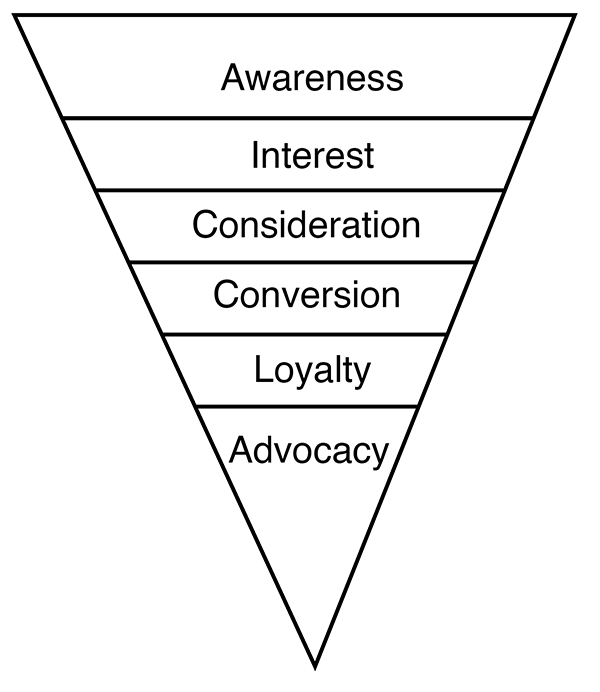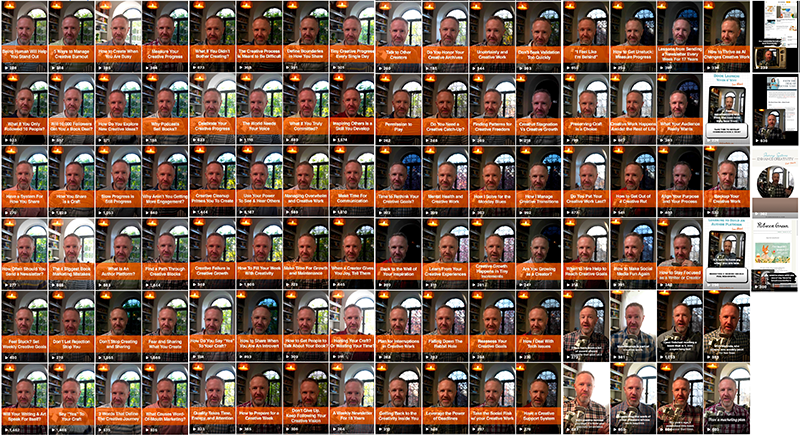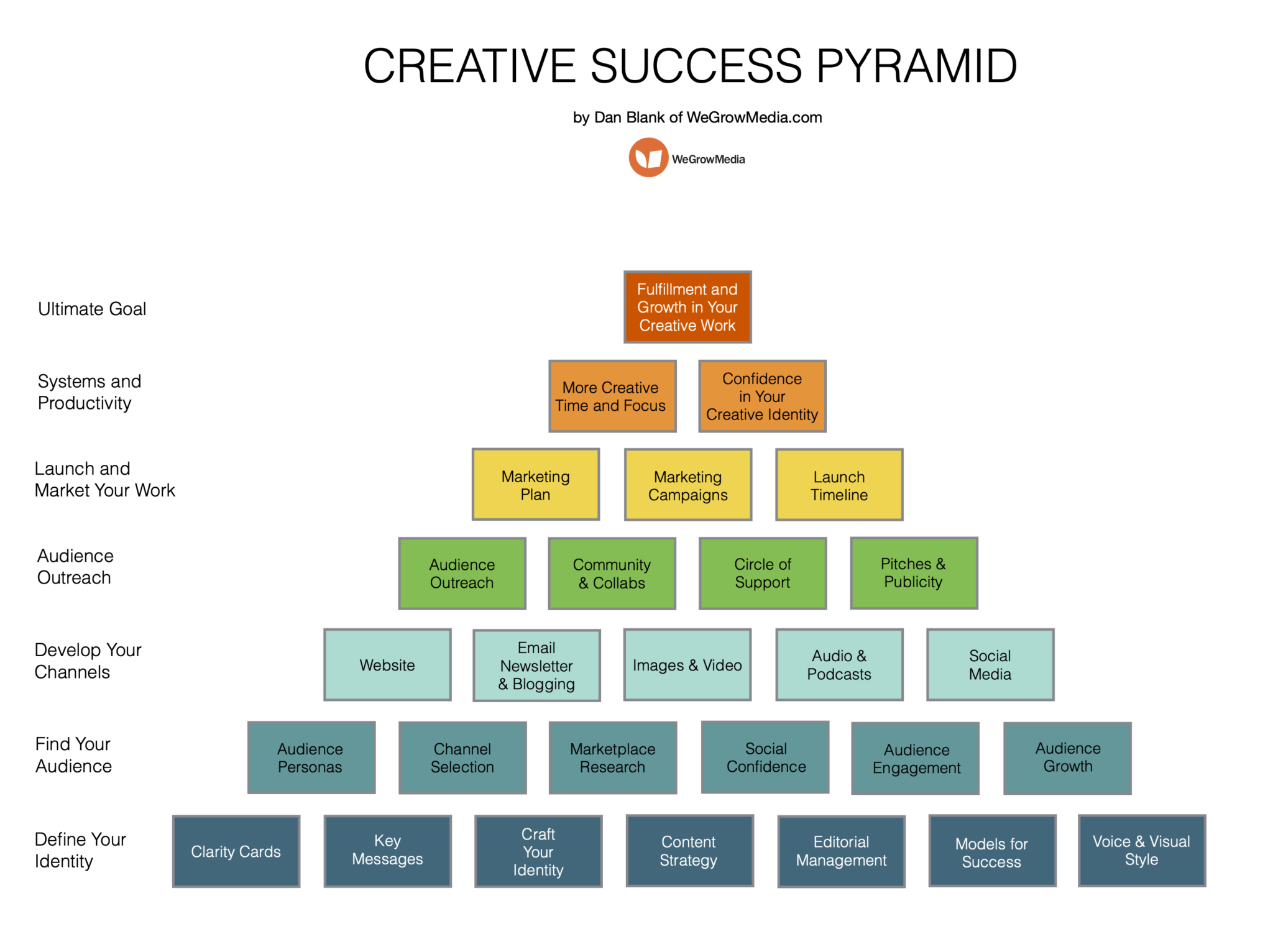Last week I talked about the pros and cons of focusing on growing followers online. Today I want to explore that further, and use this as a framing: this week I celebrated sharing 100 daily videos on Instagram. Each day I recorded a 1-minute video with advice on creating and sharing. This is what all 100 of them look like:
You can see them all here. Of course the first thing to notice is the content. Every day I showed up on camera. This aligns with a lot of traditional “best practices” around content: making it frequent, original, keyword-rich, and aligned to the work I have done in helping writers full-time for 13 years. Here is a sampling of some of the video topics:
- How to get people to talk about your book
- How to share when you are an introvert
- How do you say “yes” to your craft?
- How to fill your week with creativity
- Will your writing and art speak for itself?
- Fear and sharing what you create
- Find a path through creative blocks
- 5 ways to manage creative burnout
But the value here is not just about the content, it’s also about the connection with others. As I’ve said many times, the work we do in sharing what we create is about communication and trust. The things that are inherently human.
My methodology for helping writers share what they create focuses on this. It’s a system, and baked into it all is a focus on effective communication, meaningful relationships, collaboration, and how what we create connects us to each other.
Let’s talk about some lessons from sharing 100 days of videos…
Growth in Engagement and Audience
Of course, the easiest way to talk about “results” is to discuss numbers. I didn’t have any specific goals when I started sharing daily videos, but I began tracking some basic data midway through. The results? I’m growing followers way faster on Instagram than I ever have.
Since March 1st when I started this, I’ve had about 20% growth in followers. For comparison, it previously took an entire year to see that kind of growth before.
But more than that: engagement is way up. More likes, more comments, more people mentioning the videos to me via phone and email. It feels amazing when someone comments or mentions a video or reshares it. Just to know that I did something that inspired or helped a writer or creator.
It’s been neat to see which videos reach more people. Most of them get hundreds of views, but one had nearly 15,000 and plenty of others have had 1,000+ views. Is the goal MORE NUMBERS? Of course not. But it is a useful metric to see if my message is reaching people.
And for those of you who are more business-minded, these 1-minute videos fit into a traditional marketing funnel as well. Right there at the top, the widest part:

The videos helped people consider how they can create and share their writing. In doing so, it made more people aware of my mission. The videos give a nice open “way in” to what I do.
Could someone see a video, then follow me? Then like what I share and see that I have a podcast and listen to that? Then hear me mention my newsletter and subscribe to that? Then read my book? Then maybe one day hire me, or recommend my work to a friend? It’s all possible. And it can start with a simple 1-minute video.
I would encourage you to think about this for your own goals. What are the things you can do that lead people toward your work, then to engage with you in ways that matter to you. A marketing funnel is rarely one step. It takes time for people to become aware of your work, to understand it and see if it aligns to what they value, to consider if they want to make it a part of their life, to actually take the step to buy your book or read your essay, then to choose to hear from you again, and potentially recommend your work to others, perhaps throw a book review. That is why the concept of having an author platform even exists, to provide writers a variety of ways for readers to learn about your writing and consider if it is for them.
Even though I’ve shared online since 2006 and this has been my full-time work since 2010, I would say I’ve learned a few things through these 100 daily videos:
- I am finding new ways to share my voice. The limit of a one-minute video turned out to be a wonderful way figure out new forms of expression. I’ve often said that art thrives with limits, and this is no different. To share one useful thing for 1-minute a day became a challenge at first, then a nice creative canvas.
- Sharing my actual voice and face each day felt really nice. To show up in someone’s feed, just me being me. Perhaps it reminded me of walking into a local coffee shop and saying hello to all the regulars. Talking about how we can create and share is the real me. I’m not here to entertain you. I simply admire people who write and feel that magical things happen when they share. So I’m gonna talk about that every day.
- Sharing frequently increases the chance of luck. What kind of luck? Reaching more people in a manner that is meaningful to them. The difference between sharing once a day and once a week over the course of a year? 313 more chances each year to connect with another human being.
- It feels great to have created an archive of helpful videos so quickly. I mean imagine this: going from “Ugh, I’ve never really done much with Instagram Reels,” to “Wow, I’ve shared 100 Reels, all aligned to what I love talking about, within a 3 month period.”
- Sharing gives people new ways into your work. Each video is a seed. In some ways, I never know when it inspired someone, when it helped them, when it may encourage them to take a positive action that I wouldn’t be made aware of. This is why we share what we create.
As I write this, something I’m noticing is that so many of the “results” I am talking about here are internal. Creating these videos and sharing them has helped me as a creator, and as a human-being. The results of what we create and share need not always be measured as an “impact” in the world. Sometimes the most powerful results are what changes inside you.
Why Vertical Video Matters Right Now
So why am I doing these kinds of videos? Well, I would describe them as “vertical video.” These vertically framed videos (thin and tall, instead of short and wide) are the lifeblood of TikTok. And the success of TikTok has caused YouTube, Facebook, and Instagram to not just embrace vertically oriented videos, but prioritize them.
What I have found in the process is this: when I share vertical videos through Instagram Reels, they show it to more people who don’t follow me. So what this means is that it is solving for the issue that so many people face on social media: “how do I extend my reach?”
There are other benefits:
- Since all the major social networks now have vertical video, you can create a video for Instagram Reels, then also upload it to TikTok, Facebook Reels, and YouTube Shorts. This is also partly why I kept my videos to a 1-minute length, YouTube Shorts still has that time limitation.
- Since Instagram doesn’t want to lose audience to TikTok, they have been embracing Reels and from what I have seen, they are promoting this content to new people more than other things you share on Instagram, such as photos on the main grid feed, or Stories.
- Because of this, it feels more likely to go “mini-viral” through Instagram Reels than their other feeds. I say “mini-viral” because I know I’m not posting something that goes viral. But it feels good, when a video suddenly gets 10,000+ views, which is more than my average views to a photo.
- When you create an Instagram Reel, you can easily share it to Instagram’s other two feeds: the main grid, and the Stories feed. I find that some people primarily look at one or the other, so it’s nice to feel that I am “covering all my bases” on Instagram and their somewhat confusing system of feeds.
Do you have to do vertical videos? Nope. Do you have to put your face in them like I did? Nope. But I have found that people resonate with video, and vertical video in particularly has been engaging to people in new ways. Using them is a communication skill you may want to consider developing.
My Step-By-Step Process for Creating Daily Videos
After just a few days of doing these videos, I fell into a repeatable process that I stopped thinking about. This is exactly how I create a 1-minute video each day:
- Think of an idea. Sometimes this happens as I’m turning on my studio lights just before recording. While I have started a spreadsheet to plan out some video ideas, I still find on most days I am simply recording a video of a topic I am thinking about at the moment.
- Turn on 2 studio lights, my camera, the teleprompter monitor, and move my mic over to be in front of me. These tools are all set up and ready to go at a moment’s notice, so it’s just the matter of a few small movements.
- Write a brief script in a text file. I open up a file and jot down an idea for the title of the video, and then just a few points I want to cover.
- I open up my web browser and type “stopwatch” into Google and one pops up. This helps me time if I am coming close to the 60 second limit.
- I open up Quicktime to check the lighting, if I am framed well, and if my hair is doing anything weird.
- I record these using a program called Screenflow. But honestly, any basic video recording app would do, such as Quicktime.
- I start the stopwatch and click record. Mostly I do one take. Sometimes I have to do two if I mess up, or find I am running over the 1-minute mark.
- I do a simple edit of the video within Screenflow: cropping the video to 1080×1920 (the vertical video dimensions), cutting off the very beginning and very end, and then exporting it.
- I open up thumbnail image template I created in Photoshop, change the text to the title of today’s video, add in new screenshot from video, and save that.
- Then I move the video file and thumbnail file to Dropbox.
- On my phone access those files via Dropbox app and save to my camera roll.
- Then I open up Instagram, click to create a new Reel, and select that video file.
- I use the “transcript” sticker, double-check for any small changes I need to make in the transcript, and reposition it.
- I upload the thumbnail, then type out the title of the video. I rarely bother with hashtags.
- I keep the box checked that also posts the Reel to my Instagram grid.
- After it uploads, I click the little paper airplane icon to also share it on my Instagram Stories.
- Then on my phone, I upload the video to TikTok, Facebook Reels, and YouTube Shorts. I don’t bother with a transcript or thumbnail for any of those.
Do you have to use this process? Nope. You can just take out your phone, open Instagram, record a Reel and post it in a few steps.
How long does it all take? I recorded the time one day this week, and it felt like the average time per day: 15 minutes in total. This is how it broke down:
- 2 minute to think of an idea, write the script, and turn on the equipment.
- 4 minutes record and edit the video.
- 9.5 minutes to upload the video to all four social networks.
It is certainly funny for me to reflect on what this says about the process for someone to write, prepare to publish, and then share their work. Writing is work. But so is preparing to publish. And of course, sharing is too. Sometimes the writing can take 4x longer than sharing, but sometimes it works out the opposite. To me, I see this all aligned to the same goal: sharing your voice. Each part of this process feels essential to that purpose, regardless of how long one step takes over another.
Is it Worth It?
I think so. Instead of thinking, “Will I stop?” I more often ponder the opposite: “What would happen if I did two videos per day? Or three?”
A writer I’m working with recently said to me that since we began working together her sense of belonging to, and engagement with her literary community has increased. That is what I have found in this process as well. It just feels wonderful to be engaged with the people who inspire me.
While one could view this as a “content strategy with measurable metrics, aligning to the Instagram algorithm,” I think it is about so much more.
It’s how we share what we create. It’s how we make our voices heard. It’s how we connect with others. It’s how we learn what it means to be public with the writing and art that matters most to us.
And of course, if you ever want help with any of that, you can learn more about my process of working with writers here.
Thanks!
-Dan


